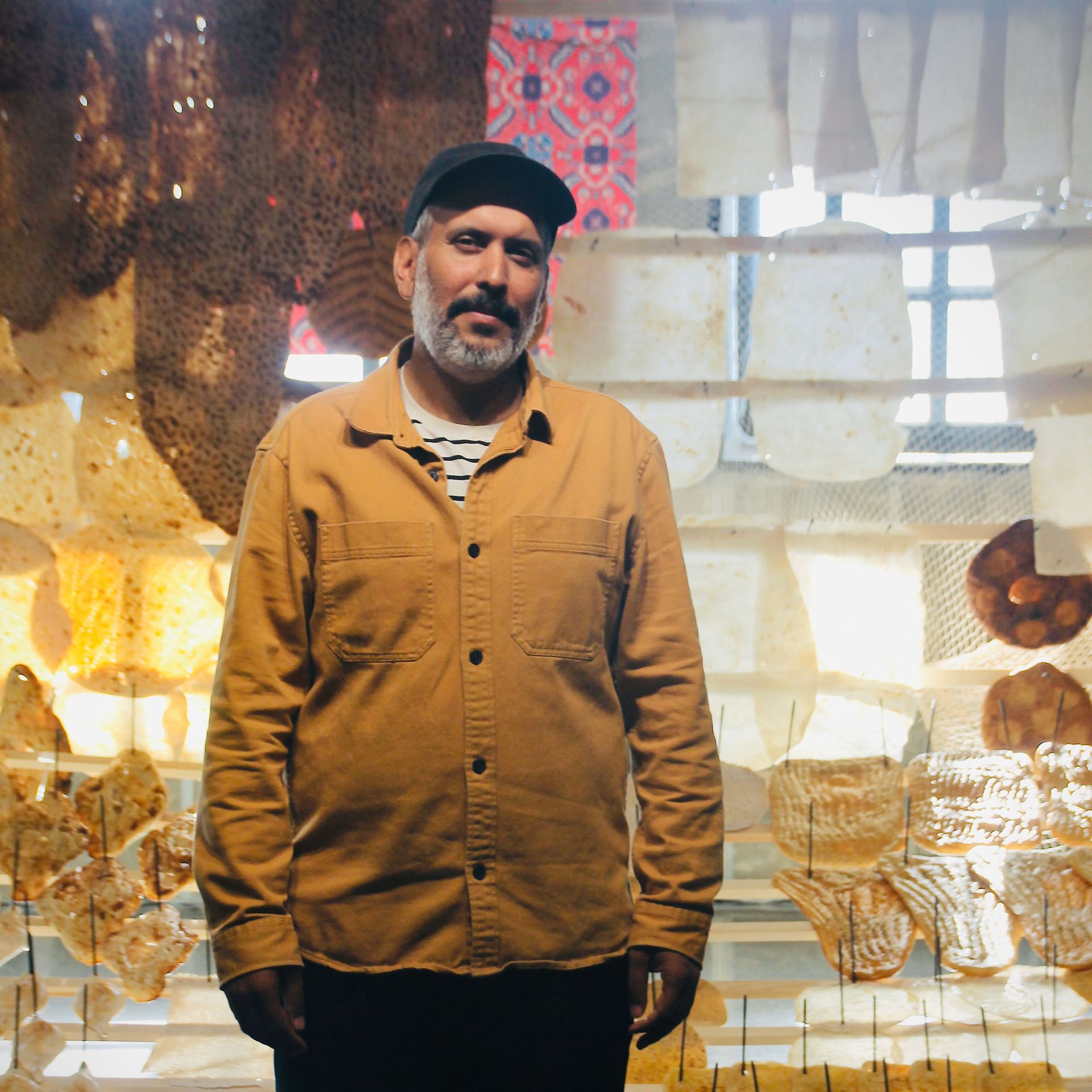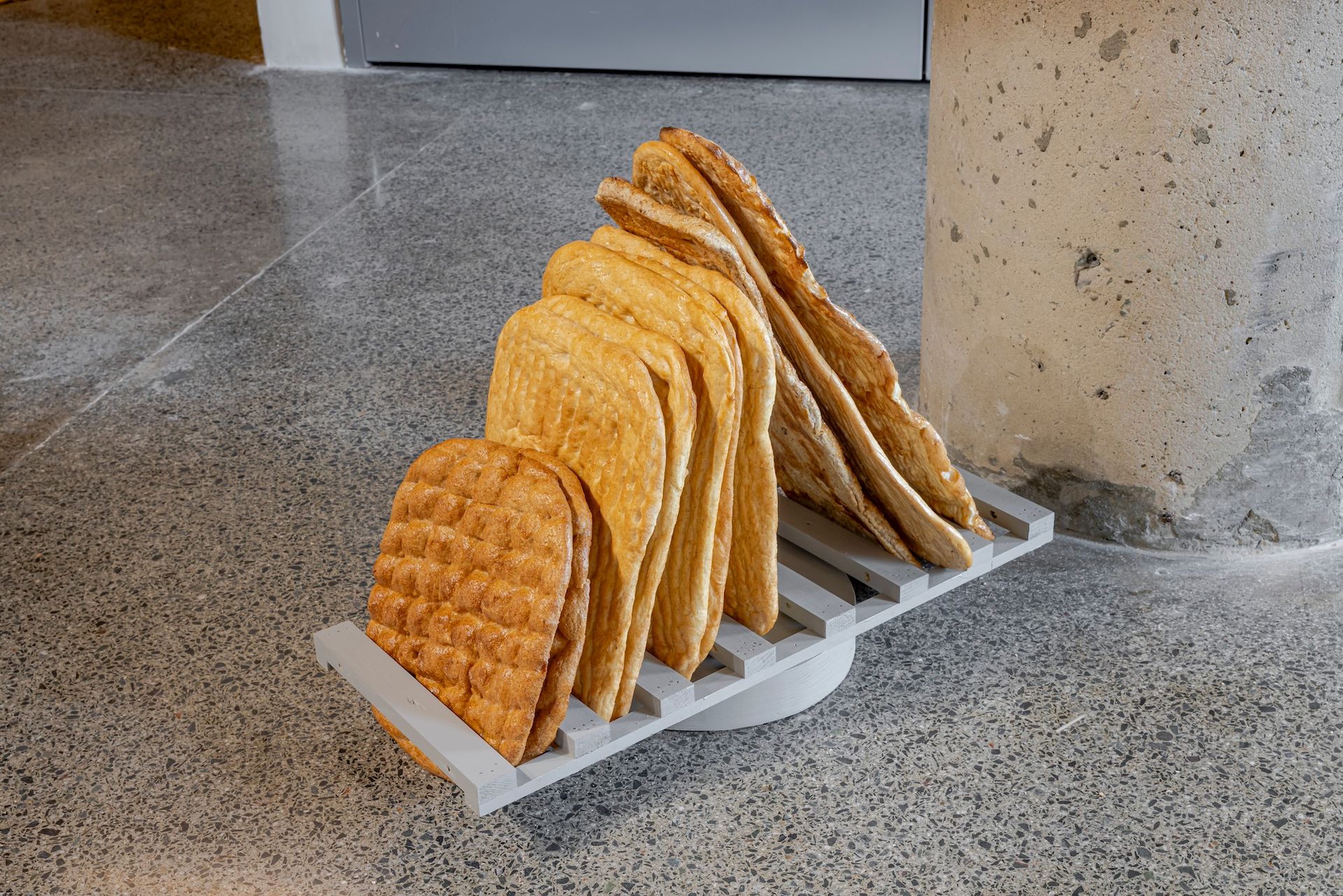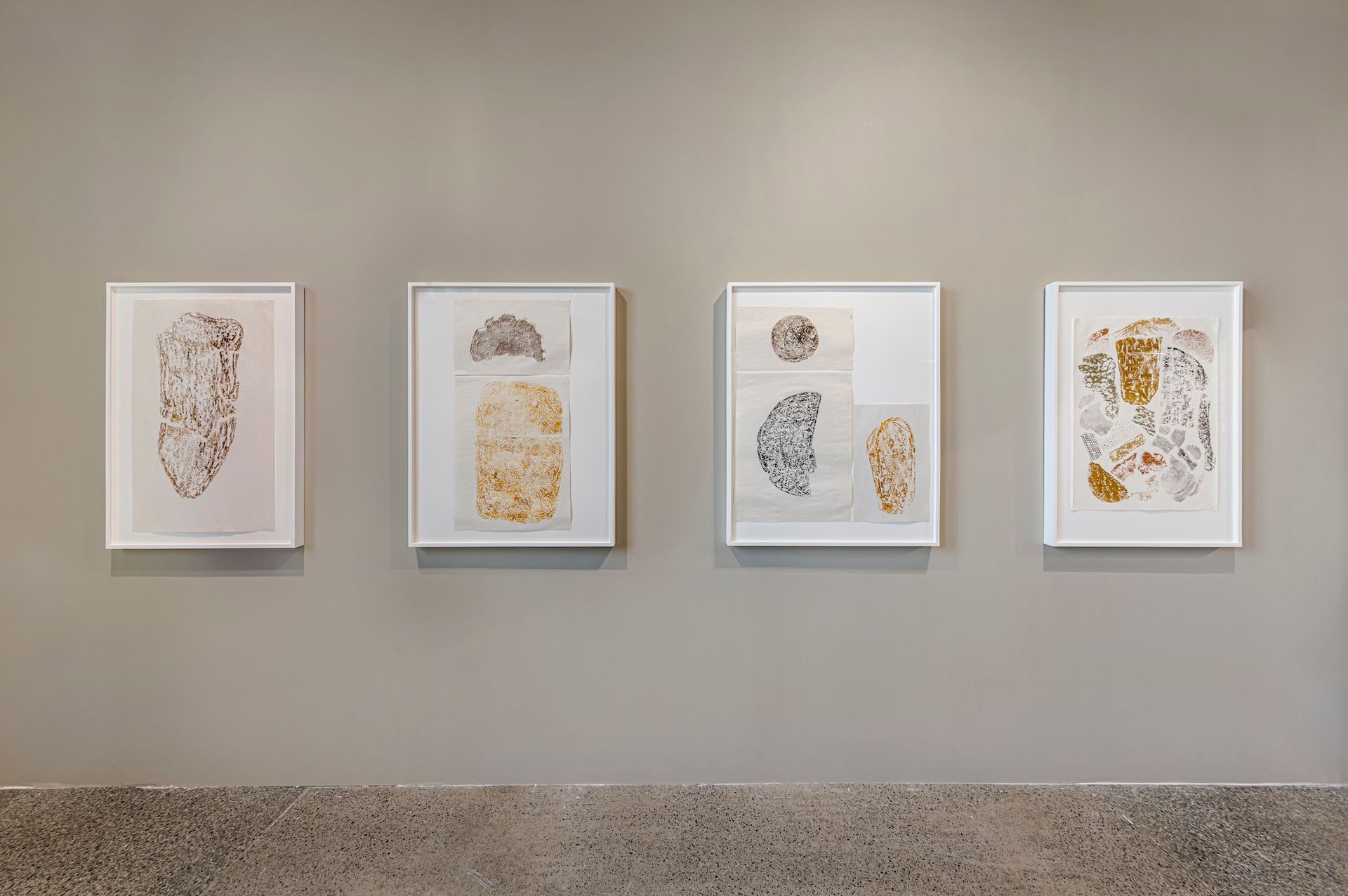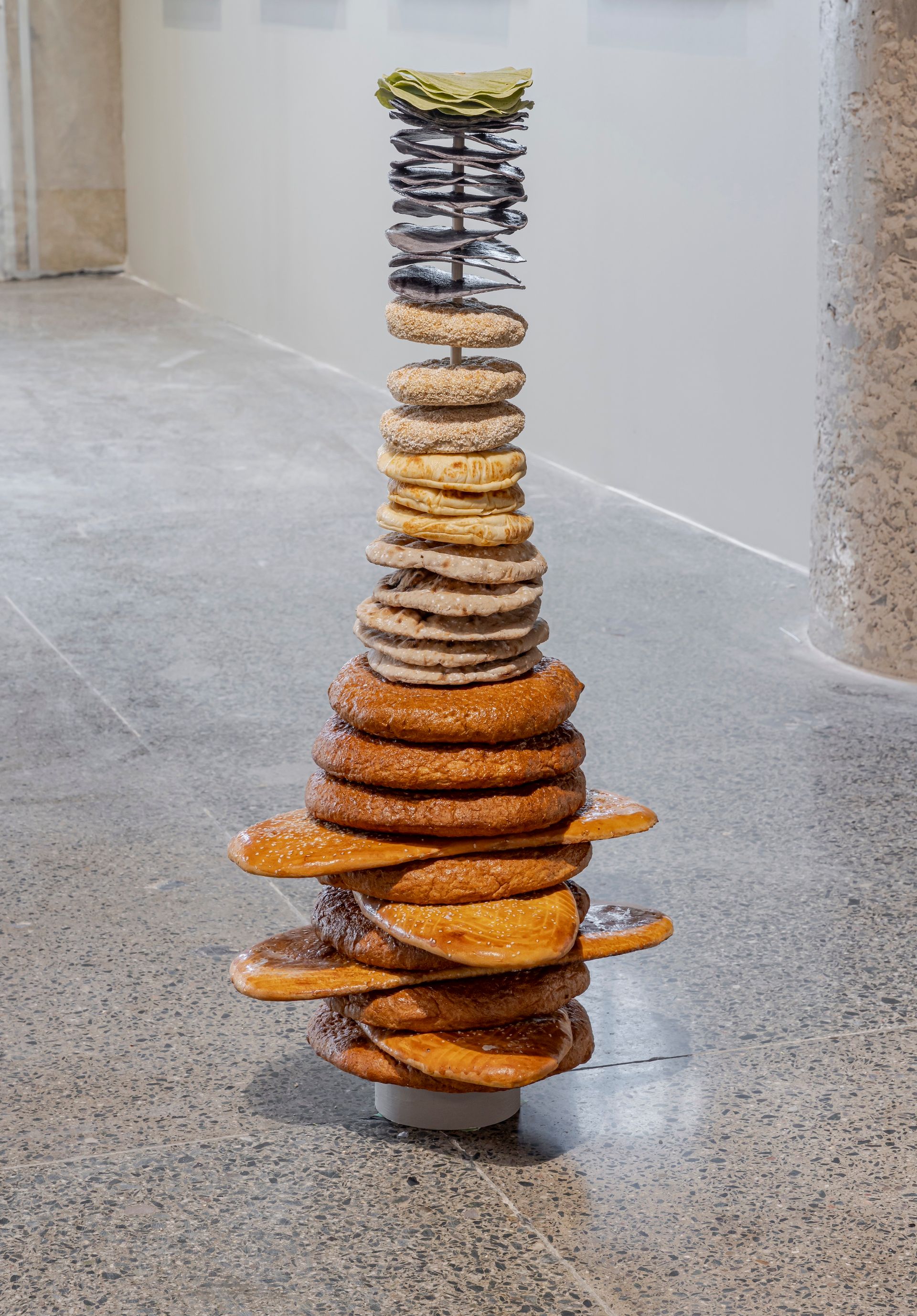
Sameer Farooq‘s sublime work The Flatbread Librarya highlight of the Toronto Biennial of Art (until December 1), was inspired by the artist’s 2019 visit to Pakistan with his father.
Farooq – who grew up in Cape Breton, Nova Scotia, where his Pakistani father was a doctor and Ugandan Ismaili mother a midwife – stayed with his aunt in the mountainous region of Peshawar, bordering Afghanistan. A journey to the local tandoora community bakery common in South Asia, where locals bring their bread to be baked, proved revealing.
“I was really sculpturally inspired by the different types of bread there,” says Farooq The Art Newspaper.“They had different textures and stamps designating specific bakeries, and each bakery had its own pattern or motif printed on the bread.”
He explains that bakers purchase bread stamps from woodworkers at the market to put patterns on the bread and make other marks and indentations with their fingers to indicate some kind of signature. They often place bread on rugs hanging from hooks, or lay it flat on rugs on the floor as a kind of display.

Sameer Farooq with his installation, The Flatbread Libraryas part of the Toronto Biennial of Art 2024 © Hadani Ditmars
It was a eureka moment for the Toronto-based artist, as he reimagined flatbread as a kind of textile, which he weaves together in his installation with grace and ingenuity. It was also the beginning of years of research into tandoors that took the artist to Turkey, Uzbekistan, Tajikistan, Morocco and Mexico. He discovered that these ovens were vehicles for building community everywhere.
“My father always says that bread is like the newspaper,” he says. “When the baker delivers bread door-to-door, he or she also spreads the news and gossip of the community.”
He also learned that flatbread has a kind of universality, transcending boundaries and identities, just like the Sufi traveler of the food world – something Farooq personally identified with. He sees flatbreads as repositories of “embedded memory,” both collective and historical.

Sameer Farooq, Flatbread library2024. On view at The Auto BLDG, 9th Floor as part of the Toronto Biennial of Art, 2024. Co-commissioned and co-presented by the Toronto Biennial of Art and the Agnes Etherington Art Centre. With thanks to the artist and Galerie Nicolas Robert. Photography: Toni Hafkenscheid.
Inspired by his practice of critical reading and reimagining of narrative strategies in museums, the flatbread story quickly became an obsession. In 2020, Farooq built a tandoor oven installation at the Scarborough Museum and, in February 2023, another at the Materia Abierta School in Mexico City. In both cases, he held community gatherings around the ovens where flatbreads were baked and shared.
He also began to focus on the flatbread as an art material, preparing a show in the winter of 2023 at Le 19 CRAC, a cultural center in the French Alpine town of Montbeliard, near the Swiss border. That was a “maquette” for his Toronto Biennial project, he says.
With joint funding from the Toronto Biennial and the Agnes Etherington Art Center at Queen’s University, where he was artist-in-residence earlier this year, he began researching the many diaspora bakeries in the Greater Toronto Area that offer tandoors or other types community centers used. ovens for making flatbread. These ranged from Armenian, Indian and Mexican to Afghan, Iranian, Pakistani, Lebanese and other flatbread traditions. He also met a Gaza mother and her daughter, who had their own traditional clay oven on their veranda, where they made Palestinian taboon. Farooq has created a special booklet with interviews with the women about the connection between their bread, their history and ancestral memories of food.

Sameer Farooq, Leftovers (1–4), 2024. On view at The Auto BLDG, 9th Floor as part of the Toronto Biennial of Art, 2024. Co-commissioned and co-presented by the Toronto Biennial of Art and the Agnes Etherington Art Centre. With thanks to the artist and Galerie Nicolas Robert. Photography: Toni Hafkenscheid.
All these breads are detailed in a special publication accompanying his exhibition at the Toronto Biennale, describing their delicate aspects lavash from Iran, Armenia and Turkey, the Indian Naan And rotiand the Mexican tortilla-each with its own unique design, texture and taste.
Drawing on his background as a ceramicist, Farooq uses a technique used in making clay tiles. He dries the loaves under drywall, where the plaster in the drywall draws moisture from the loaves and keeps them flat. Once the loaves are dry, he coats them with shellac and a product called “flexi paint,” which turns the loaves almost rubbery, making them less fragile and easier to work with.
Using the loaves as sculptural materials and inspired by the “curtains” of Sangak seen in the markets of Iran, he hangs them from a simple wooden frame, supported by mesh and carpet, suggesting a flowing textile. The effect is a kind of flatbread shrine, where different nationalities of bread – and, by extension, different peoples – coexist and connect with each other, their histories intertwined.
“The word for bread in Egypt is aish or ‘life,’” he says. Given the inviolable status of bread, it is considered a sin to throw it away. So Farooq used leftover bread to create a series of monoprints, which he covered with oil-based ink and then placed on paper. The bread compositions were then passed through a printing press and the bread was removed, revealing the print. The delicate, ephemeral patterns resemble fingerprints or stamps – and reflect the title of the biennial: Precarious joys.

Sameer Farooq, Flatbread library2024. On view at The Auto BLDG, 9th Floor as part of the Toronto Biennial of Art, 2024. Co-commissioned and co-presented by the Toronto Biennial of Art and the Agnes Etherington Art Centre. With thanks to the artist and Galerie Nicolas Robert. Photography: Toni Hafkenscheid.
Farooq also made sculptures from preserved bread: two pagoda-like stacks of round loaves and one of rectangular shapes that he calls a ‘library’.
While the works themselves are libraries of embedded, imprinted memories, the large hanging installation is also a kind of alternative map of Toronto: a city of diaspora neighborhoods expressed in the beauty, fragility and very ephemeral nature of the things of life .
On November 3, Farooq invited all the local bakers he befriended to a flatbread party, expanding a banquet table from the installation and creating a wonderful sense of community.
- Sameer Farooq: The Flatbread Libraryuntil December 1, The Auto BLDG, ninth floor, Toronto, part of the Toronto Biennial of Art 2024
Leave a Reply